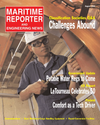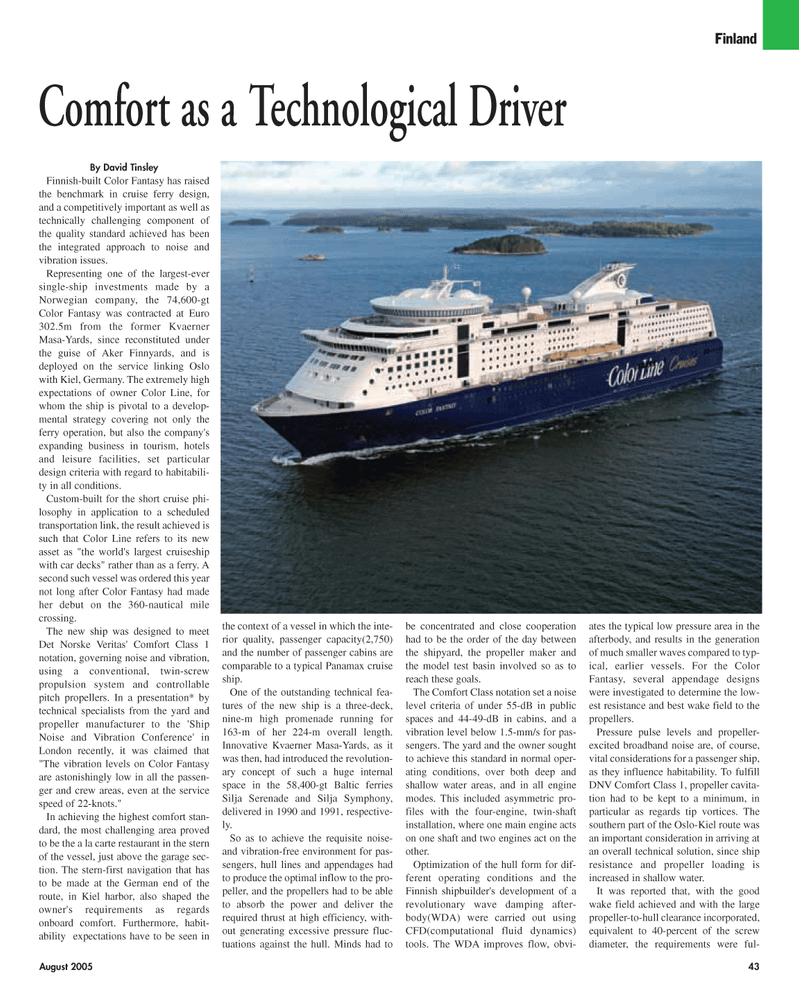
Page 43: of Maritime Reporter Magazine (August 2005)
AWO Edition: Inland & Offshore Waterways
Read this page in Pdf, Flash or Html5 edition of August 2005 Maritime Reporter Magazine
August 2005 43
Finland
By David Tinsley
Finnish-built Color Fantasy has raised the benchmark in cruise ferry design, and a competitively important as well as technically challenging component of the quality standard achieved has been the integrated approach to noise and vibration issues.
Representing one of the largest-ever single-ship investments made by a
Norwegian company, the 74,600-gt
Color Fantasy was contracted at Euro 302.5m from the former Kvaerner
Masa-Yards, since reconstituted under the guise of Aker Finnyards, and is deployed on the service linking Oslo with Kiel, Germany. The extremely high expectations of owner Color Line, for whom the ship is pivotal to a develop- mental strategy covering not only the ferry operation, but also the company's expanding business in tourism, hotels and leisure facilities, set particular design criteria with regard to habitabili- ty in all conditions.
Custom-built for the short cruise phi- losophy in application to a scheduled transportation link, the result achieved is such that Color Line refers to its new asset as "the world's largest cruiseship with car decks" rather than as a ferry. A second such vessel was ordered this year not long after Color Fantasy had made her debut on the 360-nautical mile crossing.
The new ship was designed to meet
Det Norske Veritas' Comfort Class 1 notation, governing noise and vibration, using a conventional, twin-screw propulsion system and controllable pitch propellers. In a presentation* by technical specialists from the yard and propeller manufacturer to the 'Ship
Noise and Vibration Conference' in
London recently, it was claimed that "The vibration levels on Color Fantasy are astonishingly low in all the passen- ger and crew areas, even at the service speed of 22-knots."
In achieving the highest comfort stan- dard, the most challenging area proved to be the a la carte restaurant in the stern of the vessel, just above the garage sec- tion. The stern-first navigation that has to be made at the German end of the route, in Kiel harbor, also shaped the owner's requirements as regards onboard comfort. Furthermore, habit- ability expectations have to be seen in the context of a vessel in which the inte- rior quality, passenger capacity(2,750) and the number of passenger cabins are comparable to a typical Panamax cruise ship.
One of the outstanding technical fea- tures of the new ship is a three-deck, nine-m high promenade running for 163-m of her 224-m overall length.
Innovative Kvaerner Masa-Yards, as it was then, had introduced the revolution- ary concept of such a huge internal space in the 58,400-gt Baltic ferries
Silja Serenade and Silja Symphony, delivered in 1990 and 1991, respective- ly.
So as to achieve the requisite noise- and vibration-free environment for pas- sengers, hull lines and appendages had to produce the optimal inflow to the pro- peller, and the propellers had to be able to absorb the power and deliver the required thrust at high efficiency, with- out generating excessive pressure fluc- tuations against the hull. Minds had to be concentrated and close cooperation had to be the order of the day between the shipyard, the propeller maker and the model test basin involved so as to reach these goals.
The Comfort Class notation set a noise level criteria of under 55-dB in public spaces and 44-49-dB in cabins, and a vibration level below 1.5-mm/s for pas- sengers. The yard and the owner sought to achieve this standard in normal oper- ating conditions, over both deep and shallow water areas, and in all engine modes. This included asymmetric pro- files with the four-engine, twin-shaft installation, where one main engine acts on one shaft and two engines act on the other.
Optimization of the hull form for dif- ferent operating conditions and the
Finnish shipbuilder's development of a revolutionary wave damping after- body(WDA) were carried out using
CFD(computational fluid dynamics) tools. The WDA improves flow, obvi- ates the typical low pressure area in the afterbody, and results in the generation of much smaller waves compared to typ- ical, earlier vessels. For the Color
Fantasy, several appendage designs were investigated to determine the low- est resistance and best wake field to the propellers.
Pressure pulse levels and propeller- excited broadband noise are, of course, vital considerations for a passenger ship, as they influence habitability. To fulfill
DNV Comfort Class 1, propeller cavita- tion had to be kept to a minimum, in particular as regards tip vortices. The southern part of the Oslo-Kiel route was an important consideration in arriving at an overall technical solution, since ship resistance and propeller loading is increased in shallow water.
It was reported that, with the good wake field achieved and with the large propeller-to-hull clearance incorporated, equivalent to 40-percent of the screw diameter, the requirements were ful-
Comfort as a Technological Driver
MR AUGUST 2005 #6 (41-48).qxd 8/4/2005 9:10 PM Page 43

 42
42

 44
44
